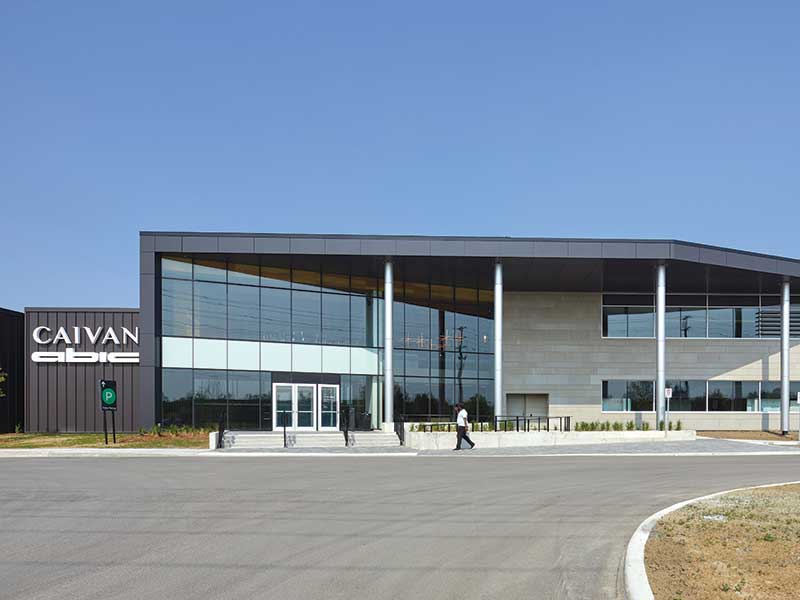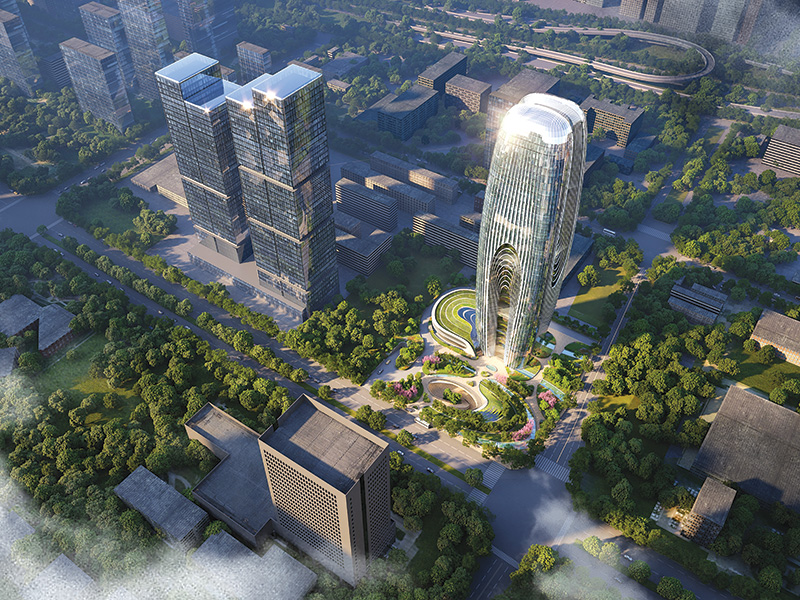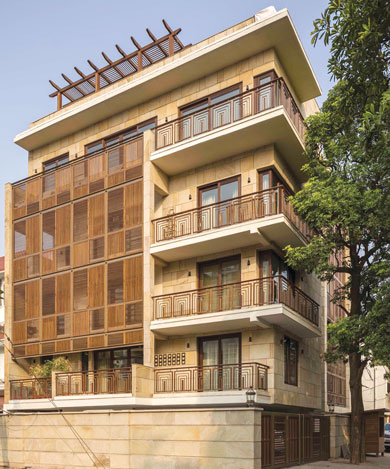
Timber screens have been juxtaposed with cleft cut sand stone on the building’s exterior
Physical Context and Spatial Organization: Located on the street corner of a residential plotted development, the house is open on three sides. Neighbouring buildings partly shade the west and southern facades of the residence while the north and eastern facades are shaded by an operable timber screen. Localized plantations in the form of trees and plants further shade specific parts of the building.
The building is organized over seven floors. A basement with a home office and theatre serves as a common living space for the two apartments on the ground and first floors and the duplex on the second and third floor. The ground plane provides for car parking while the roof has services along with an outdoor deck.
Structure and Materiality: Built on a reinforced concrete structural frame, the building's external walls are in masonry with a layer of insulation sandwiched between them. The exterior sandstone cladding is of two types: dry fixing with stainless steel clamps and wet wall (mortar) cladding. This increases the thermal mass and in the case of the dry wall cladding simultaneously acts as a cavity wall. Likewise, the roof slab is also insulated.
| Project: | Multi Unit Single Family Residence |
| Location: | New Delhi |
| Built Area: | 11,698.09 sq ft |
| Status: | Completed on March 2015 |
| Architect Firm: | RLDA, New Delhi |
| Principal Architects: | Rahoul B. Singh, Lakshmi Chand Singh |
| Photographers: | Randhir Singh, Rahoul B. Singh, Asif Khan |
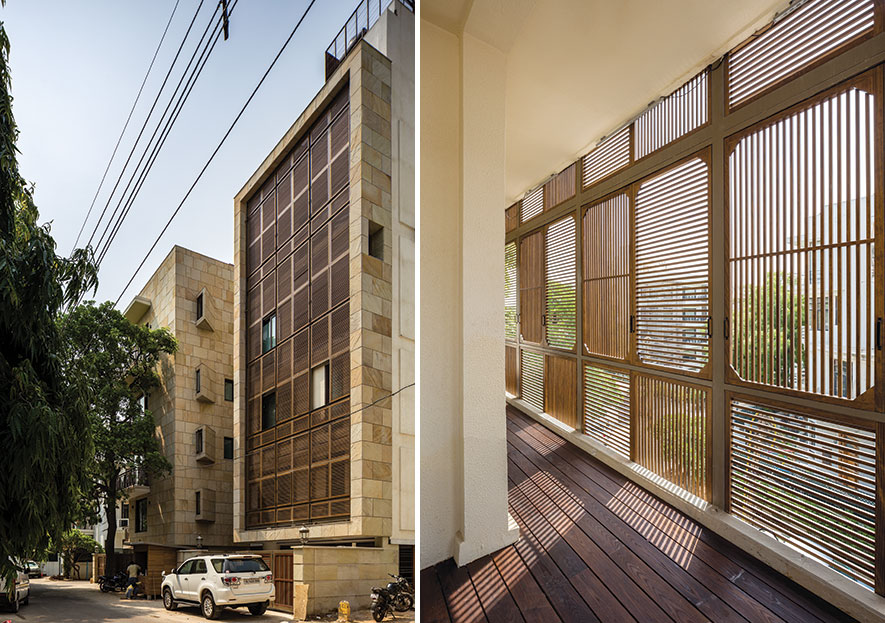 |
|
| The building’s facade addresses two urban conditions: a residential street and an institutional front | The frailty of the timber screen along with the shadows it casts on the floor is in sharp contrast to the stoic and robust sandstone |
Project Significance and Impact: The significance and impact of this project lies in the recognition of a sociological shift and return to the traditional joint family residence on what was originally zoned as single family plotted houses. As a result, unlike in the past where the rooms were arranged on the horizontal plane, here they are arranged vertically. The incorporation of a passive design strategy in a reinvented traditional housing type makes this a sustainable model for the future.
Manifestation: Identifiable by the juxtaposition of the delicacy of a timber screen and the cleft cut sand stone on the building's exterior, the project exploits the resilience of traditional building elements that have characterized Delhi's architectural landscape over the centuries.
Spatially organized over seven floors - a basement office, ground level parking, two single level apartments, a duplex unit and staff rooms on the top, the building's facade addresses two urban conditions - a residential street and an institutional front.
The juxtaposition of transparency (of the timber screen) and opacity (of the stone clad walls) on the buildings institutional face as independent planes is "humanized" by way of inhabitation on the buildings residential side facade.
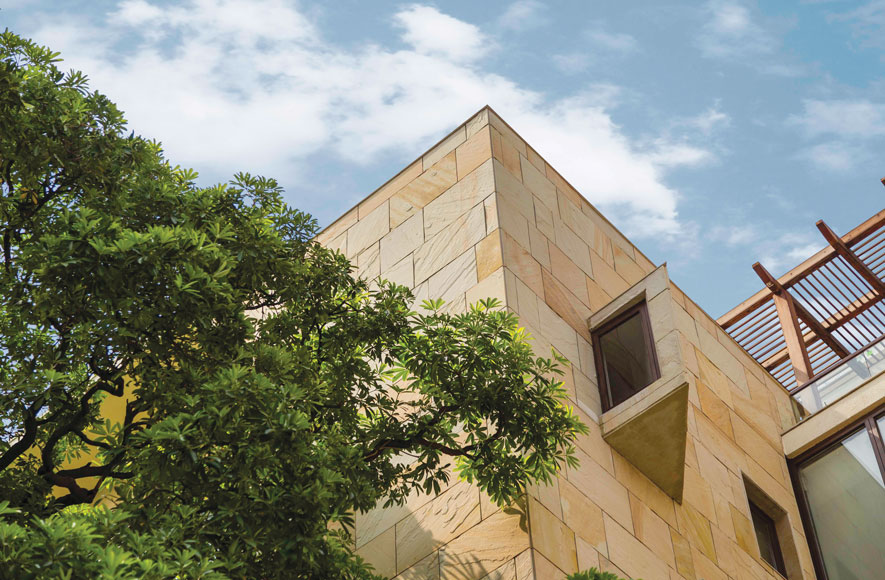
The frailty of the timber screen along with the shadows it casts on the floor is in sharp contrast to the stoic and robust sandstone. Together they create a space of great tactile quality. The operability of the screen creates differing levels of privacy for the inhabitants while simultaneously enabling one to engage with the residential street below. The screen's shadows shade the building's façade and protect it from both rain and sun.
The strong vertical planes of the timber and steel frame screen along with the adjoining cleft cut sand stone exterior face give the building an institutional presence on a street that faces the neighborhood's Sikh and Jain temples and the local recreational club. The building here is inset in the center to allow natural light to reach deeper into it, while windows oriented towards the prevalent wind direction ensure constant cross ventilation.
Contrary to the strong vertical planes of the facade that give it an institutional presence, the horizontal slabs of each of the dwelling units on the adjacent facade recognize the residential nature of its immediate streetscape.
Passive Design Strategies:
- The building's shape and form cast a shadow onto other façades of the same building that would otherwise have been exposed to direct heat gain. The strategy aids in the passive cooling of the building.
- The building form alongwith its operable timber screens on east and north-west, allow for large amounts of modulated natural light to enter the building while also enabling cross ventilation.
- The timber screens also act as a second-skin to the building.
- Projecting windows provide privacy while capturing the wind to allow for natural ventilation.
- Secondary service areas (such as bathrooms), opening onto the service lane, insulate primary living spaces (bedrooms) from the hot western sun.
- Localized plantations shade the windows of the habitable areas on the western façade.
- Roof insulation along-with pergolas and building services insulate the top most floor.
- A layer of thermal insulation is sandwiched within the external brick wall reducing the building's heat gain.
- The wet clad stone on the façade adds to its thermal mass; in other parts, the dry clad stone provides an insulating cavity.
- All openings and glazing have insulated glass to reduce heat gain.
- Automated, low-energy LED light fixtures are used with activity zone sensors.
- VRV (Variable Refrigerant Volume) system for air conditioning has been used for low energy consumption.
- The only full glass façade is inset between two building blocks and is north facing for reduced heat gain.
- A waterfall between the ground and basement levels provides a degree of evaporative cooling in the hot summer months.
